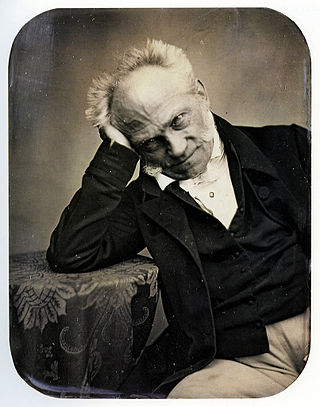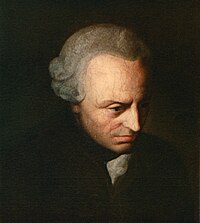
Immanuel Kant was a German philosopher and one of the central Enlightenment thinkers. Born in Königsberg, Kant's comprehensive and systematic works in epistemology, metaphysics, ethics, and aesthetics have made him one of the most influential and controversial figures in modern Western philosophy, being called the "father of modern ethics", "father of modern aesthetics" and, by bringing together rationalism and empiricism, the "father of modern philosophy".
In philosophy, a noumenon is knowledge posited as an object that exists independently of human sense. The term noumenon is generally used in contrast with, or in relation to, the term phenomenon, which refers to any object of the senses. Immanuel Kant first developed the notion of the noumenon as part of his transcendental idealism, suggesting that while we know the noumenal world to exist because human sensibility is merely receptive, it is not itself sensible and must therefore remain otherwise unknowable to us. In Kantian philosophy, the noumenon is often associated with the unknowable "thing-in-itself". However, the nature of the relationship between the two is not made explicit in Kant's work, and remains a subject of debate among Kant scholars as a result.

German idealism is a philosophical movement that emerged in Germany in the late 18th and early 19th centuries. It developed out of the work of Immanuel Kant in the 1780s and 1790s, and was closely linked both with Romanticism and the revolutionary politics of the Enlightenment. The period of German idealism after Kant is also known as post-Kantian idealism or simply post-Kantianism. One scheme divides German idealists into transcendental idealists, associated with Kant and Fichte, and absolute idealists, associated with Schelling and Hegel.

The Critique of Pure Reason is a book by the German philosopher Immanuel Kant, in which the author seeks to determine the limits and scope of metaphysics. Also referred to as Kant's "First Critique", it was followed by his Critique of Practical Reason (1788) and Critique of Judgment (1790). In the preface to the first edition, Kant explains that by a "critique of pure reason" he means a critique "of the faculty of reason in general, in respect of all knowledge after which it may strive independently of all experience" and that he aims to reach a decision about "the possibility or impossibility of metaphysics". The term "critique" is understood to mean a systematic analysis in this context, rather than the colloquial sense of the term.

In Kantian philosophy, the thing-in-itself is the status of objects as they are, independent of representation and observation. The concept of the thing-in-itself was introduced by the German philosopher Immanuel Kant, and over the following centuries was met with controversy among later philosophers. It is closely related to Kant's concept of noumena or the objects of inquiry, as opposed to phenomena, its manifestations.

The World as Will and Representation, sometimes translated as The World as Will and Idea, is the central work of the German philosopher Arthur Schopenhauer. The first edition was published in late 1818, with the date 1819 on the title-page. A second, two-volume edition appeared in 1844: volume one was an edited version of the 1818 edition, while volume two consisted of commentary on the ideas expounded in volume one. A third expanded edition was published in 1859, the year prior to Schopenhauer's death. In 1948, an abridged version was edited by Thomas Mann.

The Bounds of Sense: An Essay on Kant’s Critique of Pure Reason is a 1966 book about Immanuel Kant's Critique of Pure Reason (1781) by the Oxford philosopher Peter Strawson, in which the author tries to separate what remains valuable in Kant's work from Kant's transcendental idealism, which he rejects. The work is widely admired, and has received praise from philosophers as one of the first thorough works on the Critique of Pure Reason in the analytic tradition, although Strawson's treatment of transcendental idealism has been criticized.
In philosophy, transcendence is the basic ground concept from the word's literal meaning, of climbing or going beyond, albeit with varying connotations in its different historical and cultural stages. It includes philosophies, systems, and approaches that describe the fundamental structures of being, not as an ontology, but as the framework of emergence and validation of knowledge of being. These definitions are generally grounded in reason and empirical observation and seek to provide a framework for understanding the world that is not reliant on religious beliefs or supernatural forces. "Transcendental" is a word derived from the scholastic, designating the extra-categorical attributes of beings.

Prolegomena to Any Future Metaphysics That Will Be Able to Present Itself as a Science is a book by the German philosopher Immanuel Kant, published in 1783, two years after the first edition of his Critique of Pure Reason. One of Kant's shorter works, it contains a summary of the Critique‘s main conclusions, sometimes by arguments Kant had not used in the Critique. Kant characterizes his more accessible approach here as an "analytic" one, as opposed to the Critique‘s "synthetic" examination of successive faculties of the mind and their principles.
"Critique of the Kantian philosophy" is a criticism Arthur Schopenhauer appended to the first volume of his The World as Will and Representation (1818). He wanted to show Immanuel Kant's errors so that Kant's merits would be appreciated and his achievements furthered.

In Kantian philosophy, a transcendental schema is the procedural rule by which a category or pure, non-empirical concept is associated with a sense impression. A private, subjective intuition is thereby discursively thought to be a representation of an external object. Transcendental schemata are supposedly produced by the imagination in relation to time.

On the Fourfold Root of the Principle of Sufficient Reason is an elaboration on the classical principle of sufficient reason, written by German philosopher Arthur Schopenhauer as his doctoral dissertation in 1813. The principle of sufficient reason is a powerful and controversial philosophical principle stipulating that everything must have a reason or cause. Schopenhauer revised and re-published it in 1847. The work articulated the centerpiece of many of Schopenhauer's arguments, and throughout his later works he consistently refers his readers to it as the necessary beginning point for a full understanding of his further writings.
A priori and a posteriori are Latin phrases used in philosophy to distinguish types of knowledge, justification, or argument by their reliance on experience. A priori knowledge is independent from any experience. Examples include mathematics, tautologies and deduction from pure reason. A posteriori knowledge depends on empirical evidence. Examples include most fields of science and aspects of personal knowledge.
Aenesidemus is a German book published anonymously by Professor Gottlob Ernst Schulze of Helmstedt in 1792. Schulze attempted to refute the principles that Karl Leonhard Reinhold established in support of Immanuel Kant's Critique of Pure Reason (1781). The title is a reference to Aenesidemus, an ancient Greek Pyrrhonist philosopher. Its complete title, in English translation, was Aenesidemus or Concerning the Foundations of the Philosophy of the Elements Issued by Professor Reinhold in Jena Together with a Defense of Skepticism against the Pretensions of the Critique of Reason.
A transcendental argument is a kind of deductive argument that appeals to the necessary conditions that make argumentation itself possible. Transcendental arguments may have additional standards of justification that are more demanding than those of traditional deductive arguments.

Introduction to Kant's Anthropology is an introductory essay to Michel Foucault's translation of Immanuel Kant's 1798 book Anthropology from a Pragmatic Point of View — a textbook deriving from lectures he delivered annually between 1772/73 and 1795/96. Both works together served as his secondary thesis, although Foucault's translation of the Anthropology was published separately by Vrin in 1964. The introduction was published in an English translation by Arianna Bove on generation-online.org in 2003.
Transcendental humanism in philosophy considers humans as simultaneously the originator of meaning, and subject to a larger ultimate truth that exists beyond the human realm (transcendence). The philosophy suggests that the humanistic approach is guided by “accuracy, truth, discovery, and objectivity” that transcends or exists apart from subjectivity.
The following is a list of the major events in the history of German idealism, along with related historical events.

Critique of the Schopenhaurian philosophy is a literary work by Philipp Mainländer appended to Die Philosophie der Erlösung, offering a criticism of the philosophy of Arthur Schopenhauer. Mainländer saw the purification of Schopenhauer's philosophy as the primary task of his life. The criticism had an important impact on Nietzsche's philosophical development.

Henry Edward Allison was an American scholar of Immanuel Kant, widely considered to be one of the most eminent English-language Kant scholars of the postwar era. He was a professor and chair of the Philosophy Department at the University of California, San Diego and a professor at Boston University.











